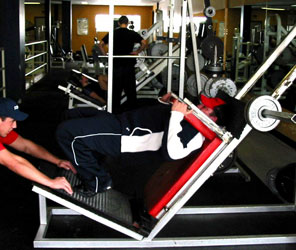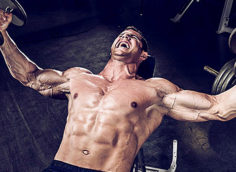Exercises You've Never Tried, Thibaudeau Style
Q: Thib, you seem to be able to come up with a lot of new and effective exercises. Got any more that I could use to spice up my training?
A: I indeed have a few tricks up my sleeve for you! But before giving you my secret exercises, I'd like to explain how I came about finding effective new exercises for most muscle groups.
I come from a strength background. I originally started lifting to improve my performance on the football field. Afterward, I competed in Olympic lifting, powerlifting, and even one strongman contest.
During that time my training influences were of a minimalist nature. This means that for me, exercise selection was actually not that important. I believed that sticking to only the basic compound exercises would be enough. And when training for strength and sports performance, it was sufficient. In fact, to this day I still train my athletes using mostly the basic stuff.
 |
When I switched to bodybuilding and began working more with individuals focusing on building an aesthetic physique, I first stuck with the same training ideology. I'd basically design bodybuilding programs with the same mentality as I would design strength and performance programs. That is, I considered exercise selection to be much less important than the other training variables.
Thib goes bodybuilding!
The thing is, when sticking with only the basic exercises, you're eventually doomed to develop serious muscular imbalances, at least as far as looks are concerned. You see, your body is a wonderful machine. In fact, for bodybuilding purposes it can be so efficient that it can hinder progress!
How can that be? Well, your body doesn't want to build a symmetrical and pleasing physique; it wants to survive! The law of minimal effort (or economy of effort) pretty much rules how the body functions. So when performing a compound exercise, your body will look for the most efficient way of performing it. This means utilizing the muscle group(s) best suited to do the job.
For example, someone who has super-strong shoulders will tend to rely more on that group when performing pressing exercises. As a result, even when trying to build the pectorals, our athlete ends up placing more stress on his delts. So his shoulders, which receive more stimulation, grow more than the chest. This emphasizes the problem even more because the gap between shoulder and pectoral strength grows wider with every week of training.
 |
Most people have several "dominant" muscle groups. So if they only use the basic compound exercises they're bound to build those groups to a greater extent than some others. For strength purposes this isn't that bad: if you're competing in powerlifting you need to be efficient at the bench press. As long as your total goes up, it doesn't matter much if your pecs get fully stimulated or not.
However, if you're training for aesthetic purposes and want to build a symmetrical physique, this situation isn't acceptable. Most people will need to use speciality exercises (or techniques) if they want to build each muscle group in proportion with the others. Don't get me wrong, you still need to perform heavy basic lifts to build a muscular physique. But when training for appearance, you should also pick exercises that'll address your own problem areas.
Plus, performing such exercises will eventually make the basic lifts more effective. How's that? Well, the body will place much of the workload on the stronger muscle groups involved in a lift. So by bringing up a weak point you'll enhance its participation in basic lifts.
For example, someone who has weak pecs will rely more on his shoulders and/or triceps when bench pressing. If he brings up his pectorals with speciality exercises to a point where they're no longer a weak link, the body will automatically begin to place more workload on the chest during his bench pressing exercises.
Hopefully you now understand the benefits of using targeted exercises. Now here are some speciality exercises I've been using with my clients. This isn't all of them, mind you. After all, I must keep some things secret!
Back Width Exercises
Rope Lat Pulldown
 |
 |
This is probably my favorite latissimus dorsi exercise because it allows us to respect the exact function of this muscle, whereas regular lat pulldown variations are more restrictive in that regard due to the use of the solid bar attachment.
For this exercise you want to use a slight torso lean (forward) to make sure that the rhomboids will be taken out of the movement. That way the lats can take on the bulk of the work. You should pull until your hands are in line with your navel. Don't simply pull the rope downward, but pull it down and back. The movement should describe a slight arc toward your torso.
At the end of the concentric portion of the lift, try to bring your shoulders down by depressing your scapula.
Eagle Pulldown
 |
 |
I like this exercise for two reasons:
1. The inclined trunk angle takes the rhomboids out of the movement and thus more stress is placed on the lats.
2. With regular lat pulldowns, the resistance is straight up, so you exert force straight down. In the eagle variation, the resistance is upward and out so you have to exert strength down and in, trying to pull your elbows to your ribcage. This greatly increase lats and teres major activity and makes it a more effective exercise.
Seated Rope Rowing (Trunk Bent Forward)
 |
 |
Most people will say that seated rowing exercises (or basically any horizontal rowing movements) will hit mostly the rhomboids, rear delts, and middle portion of the trapezius. In most cases they'd be right.
But by leaning forward on this exercise and keeping that position during the whole performance of the movement, you actually shift the workload more toward the lats and teres major. This is especially true if you pull the rope toward your hip bone (so keep a low pulling line).
Focus on pulling the elbows as far back as possible while keeping a bent forward position the whole time.
Back Thickness Exercises
Spider Rowing
 |
 |
This exercise can be performed in an inclined position (as illustrated) or seated straight up. Since you're pulling slightly upward from a low position, you'll still recruit mostly the middle portion of your upper back, even with an inclined position.
I like this exercise over regular horizontal rowing movements because, just like with the eagle pulldown, you're pulling toward you with the resistance being directed outward. This will allow you to execute a loaded scapular "squeeze," which is a powerful stimulus for rhomboid growth. Imagine trying to pinch a finger between both shoulder blades as you pull.
Rack Pull
 |
 |
This exercise is a staple in the training of many top powerlifters known for their great back thickness. It's basically a half-deadlift performed from the knees up. This will allow you to use a lot of weight while placing most of the workload on the lower back, rhomboids, and traps. It's important to keep the back tight to avoid injuries and to maximize the training effect of the movement.
Biceps
Wide Grip/Elbows-In Preacher Curl (short/inner head)
 |
 |
While you can't truly isolate one head of the biceps, it's still possible to put more stress on one of the two. Think about it: if both "parts" shared the exact same role, there would only be one part to the biceps. The fact that the body is built to include two parts actually means that both can play slightly different roles.
To put more stress on the inner portion of the biceps you must use a grip that's much wider than your elbow position. In other words, your wrists are outside your elbows during the movement.
To maximize inner portion recruitment, you should actually attempt to move the elbows inwards as you curl the bar up. Since you're using a preacher bench, your elbows probably won't move, but by trying to bring them inward you'll activate the inner portion of your biceps more.
Close Grip/Elbows-Out Barbell Concentration Curl (long/outer head)
 |
 |
If curling with the wrists outside the elbows activates the inner portion of the biceps more, the opposite (having the wrists inside the elbows) will activate the outer portion more. I like the barbell concentration curl for this purpose.
Use a narrow grip and put your elbows against the inside of your thighs. As you curl the bar up, flare out the elbows even more by pushing against your legs. Note that these first two exercises makes for one killer biceps superset!
Jettison Technique Barbell Curl
 |
 |
 |
 |
 |
 |
The jettison curl is a form of drop set. You first begin with a dual source of resistance: a barbell plus a resistance band. Perform reps to failure.
As you reach failure, drop the resistance band and continue to rep out with only the bar. When you once again reach failure, drop the bar, grab the band, and finish off with more reps to failure. This is truly a murderous technique for big guns!
Quads/Glutes
Sissy Hack Squat
 |
 |
This great exercise is from the mind of Milos Sarcev, one of the top competitive bodybuilders and bodybuilding coaches in the world. It combines a regular hack squat with a sissy squat technique.
The key point is that only your shoulders should be in contact with the machine. Your hips should be elevated as much as possible during the whole movement (eccentric and concentric phase). You won't need to use a lot of weight for this one, trust me!
Pulley Hip-Belt Squat
 |
 |
This exercise is very effective at the end of a leg workout because it allows you to put a lot of stimulus on the quads with little, if any, lower back strain. For that reason, it's also a very effective exercise for individuals with lower back problems.
Another positive thing about this exercise is that it allows you to squat down and back (sit back down) which leads to less knee strain. It's actually quite similar to a box squat as far as technique is concerned.
Try a few of these exercises this week and let me know what you think!
That's it for this installment. Hopefully you learned a few things! See you next time with a few new neat tricks!





